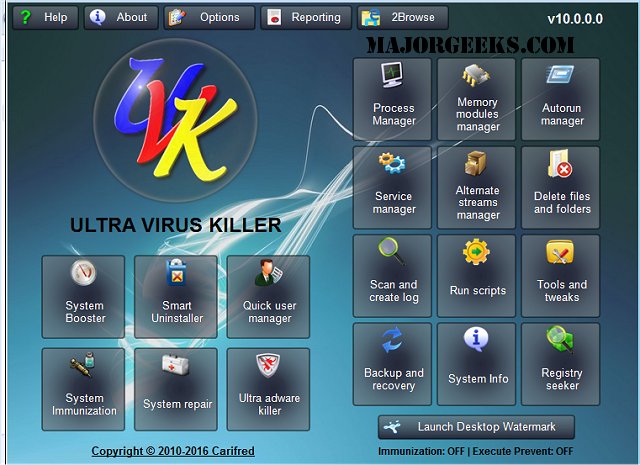UVK Ultra Virus Killer allows users to detect and delete all types of malware and spyware from infected systems.
UVK Ultra Virus Killer allows users to detect and delete all types of malware and spyware from infected systems.
With a simple and intuitive interface, UVK allows users to detect and delete all types of malware and spyware from infected systems.
For scanning and live protection, consider downloading Malwarebytes.
UVK Ultra Virus Killer Features:
Process manager:
Filter all the running processes by their executable path.
Select and manage several processes at once.
Kill processes.
Kill several processes with the same path at once.
Kill processes and delete the parent files simultaneously.
Kill all the listed processes.
Kill all the listed processes except the system processes.
Kill all non-trusted processes.
Pause and resume processes.
Verify the processes files signatures.
Search for information about a process over the internet.
Submit one or more processes MD5 to VirusTotal using the VT API.
Open the processes file locations.
View the processes executable file properties.
Startup entries and scheduled tasks:
Delete startup entries, scheduled tasks, and corresponding files simultaneously.
Select and manage several entries at once.
Verify the startup entries files signatures.
Hide Microsoft signed files from the list.
Search information about a startup entry file over the internet.
Submit one or more startup entries files MD5 to VirusTotal using the VT API.
Jump to the registry key where the startup entry is located.
Open the startup entries files locations.
View the startup entries files properties.
Maximizable window in this section for a more comfortable view.
Windows services and drivers:
Delete services or drivers and the corresponding files simultaneously.
Perform all common service management tasks: Stop, start, pause, resume services, and set their startup type.
Select and manage several services or drivers at once.
Stop all non-Microsoft services.
Choose the services and drivers to be displayed: Show all services and drivers. Hide inactive services and drivers, Hide Microsoft services and drivers, Hide inactive and Microsoft services and drivers.
Verify the services/drivers' files signatures.
Search information about a service/driver file over the internet.
Submit one or more services/drivers files MD5 to VirusTotal using the VT API.
Jump to the registry key where the service/driver is located.
Open the service/driver file location.
View the service file properties.
Maximizable window in this section for a more comfortable view.
Delete or replace file or folder:
Delete files and folders even if applications are using them.
Delete running executable files.
Delete files and folders you can't normally delete using Windows Explorer.
Choose whether deleting the files definitely or move them to the recycle bin.
Replace or copy files.
Expand compressed files.
Replace files even if they are loaded in the memory.
Scan & create log:
Perform a full analysis of your system and save it to a text file that you can send to a friend or professional, post in a forum, or analyze it yourself.
Choose the areas you want to scan and show in the log.
Choose whether to show Microsoft signed files in the log.
Choose where to save the log.
Choose whether to verify the scanned files digital signatures.
Search for recently created files, and write them to the log.
Perform other custom scans, live retrieving specific information on files, folders, registry entries, or automatically get the VirusTotal analysis result for a file.
Run UVK Scripts:
Disinfect your computer by pasting lines from the UVK log to delete corresponding registry entries and files.
Use custom commands to download files, execute programs, delete or add registry entries, terminate processes, delete files and folders, run cmd batch scripts, register system files or run the UVK Fixes.
Create a system to restore points, empty the recycling bin, and all user's temporary folders.
Create and run scripts that perform complete system repair and maintenance.
Automatically run any of the UVK fixes or scans.
Tools:
Retrieve all sorts of information on any file.
Generate VirusTotal MD5 reports, deny or grant access or perform an SFC scan for any file.
Search information on files and registry entries over the internet.
Grant access or prevent changes to registry keys.
Enumerate all the restore points.
Select and delete one or several restore points.
Create a system restore points.
Enable or disable the system restore.
System repair:
Fix your computer with more than fifty exclusive fixes: Fix file extensions, register system DLLs, enable and repair Windows update, clear DNS cache and the host's file, reset user default registry settings, fix installation problems, empty all browsers cache, reset security settings, defragment and optimize the hard drives, install Java, Flash, DirectX, .Net Framework, Fix the WMI, and the system restores, delete all restore points, fix the windows shell, reset the user shell folders and much more.
System Info:
Show information that can be very useful, especially if you're going to reinstall windows or if you need to diagnose a performance or hardware problem. This includes the processor, memory and page file usage, OS and office product keys, and hardware and user info.
Export this info to an HTML file.
Immunization:
Prevent the most vulnerable registry and file system areas from being infected.
Prevent adding programs to the windows startup and login.
Prevent creating/deleting browser helper objects, Internet Explorer toolbars, and search providers.
Prevent modifying the internet settings and the Internet Explorer startup pages.
Backup and restore the Windows registry.
Similar:
What's the Best Antivirus and Is Windows Defender Good Enough?
What to Do When Your Norton or McAfee Antivirus Expire
Download


